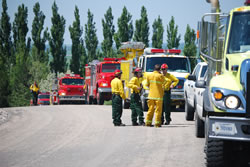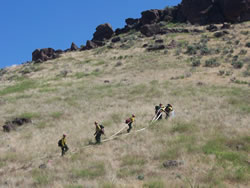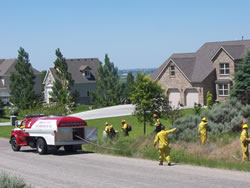
National Fire Plan Success Story
New Interagency Wildfire Group Hosts Drill
Idaho
National Fire Plan - Community Assistance
2010

Multi-Agency Initial Attack crews and engines.

Firefighters doing hose lays up a hill near the subdivisions.

Firefighters doing fire suppression around houses in the subdivision.
During recent years, growth in Idaho Falls has expanded into the foothills but remains outside of any fire district. An increase of homes in this wildland urban interface resulted in concern from local fire districts when responding to fires in these unprotected areas. Issues ranged from the cost of fire suppression to who has jurisdictional authority and who is liable if a person gets injured. These concerns came to fruition in 2007 when the Black Hawk fire (formally known as the Comora Loma Fire) burned 6,224 acres in the foothills region of Idaho Falls.
In February of 2009, a conglomerate of agencies came together to form the Upper Snake Interagency Wildfire Group (USIWG). USIWG hopes to resolve these interagency jurisdictional issues and to discuss fire protection, tactical operations, interagency communications and other fire related issues arising in these unprotected areas.
Before the 2009 fire season arrived, USIWG developed a wildfire exercise in the southeast Ammon area to work on interagency fire operations coordination. A week before the drill, USIWG personnel went door to door in the subdivisions of southeast Ammon and met with over 180 homeowners to discuss the drill and explain to the residents that this was a simulation and they should not be alarmed. The door to door communication provided an excellent opportunity to speak with locals about making their homes safe from potential wildfire.
On June 27th, USIWG hosted the wildfire training drill near the Blackhawk Estates and Comora Loma subdivisions. The fire call was initiated from the Bonneville County dispatch center at 10:00 a.m., and from that point was treated like a real wildfire. The parking area of Woodland Hills Elementary School, served as the Incident Command Post where agencies such as High County RC&D, Homeland Security, Bonneville County Sheriff’s Office and local media could meet to discuss logistics and their role in a wildfire incident.
A conglomerate of fire agencies responded to the ‘wildfire.’ The departments coordinated with the incident command system and worked quickly and efficiently to suppress the fire. The drill acted as a great opportunity for new firefighters to get a feel for the Incident Command System, coordinate with fire agencies other than their unit, work with radio interoperability and master the process of hose lays. A total of 109 people were involved in the drill.
Local homeowners were grateful for the exercise and graciously complied with the drill and its requirements. One homeowner was so appreciative that he called the BLM and said, “…We’re really grateful to you for giving us a call and letting us know that, we’re extremely grateful for that, we support you 100 percent, thank you.” Local media broadcasted an in-depth story of the drill focusing awareness on the potential threat of wildfire to homes located in the WUI area and the importance of defensible space.
After the drill an after action review occurred and agencies discussed what went well and areas that could use improvement. The biggest concern was the struggle with handheld and vehicle radios and the breakdown in communication that resulted from the incompatibility of multiple agencies’ radio systems. Local fire departments were thankful for the drill and said they learned a lot about agency cooperation and general wildland fire suppression. Overall, the drill was successful. It provided training for new firefighters, fire experience for local media, fire education for homeowners, and cooperation among fire suppression agencies. Fire agencies are remedying the radio communications problem, and agencies are more prepared for the next fire to occur in the wildland urban interface.